

The following guideline is a general overview of the proper steps involved when installing natural or manufactured thin stone veneer, in the traditional method, where no special circumstances are present. Your specific project may be unique and may require additional steps. Please contact an RCP Block & Brick to discuss your particular project. View all available Stone Veneer styles.
Before you can begin the installation project, you will need to calculate the proper amount of material for your thin stone veneer project.
Begin by figuring the square footage of the area you plan to cover with stone (length x height). If your project includes corner stones, deduct 1 square foot for each linear foot of corners that you will utilize. Not Sure? Call RCP Block & Brick and we can help calculate your stone needs.
One aspect to consider when calculating your materials is the size of the mortar joint between the pieces of stone. Most stone is packaged assuming a 1/2" mortar joint. If your joint will vary (such as a dry-stack or over grout application) adjust your estimates accordingly.
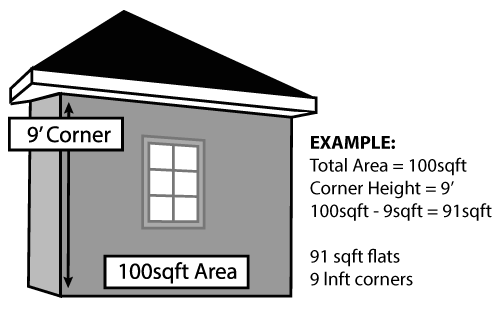
Calculating Stone Veneer Quantity
Preparation of the surface is a key aspect in preventing any water damage and making sure your stone veneer project remains structurally sound for the life of the installation.
Including Plywood Paneling, Wall Sheathing, or Flush Metal Siding
Cover surface with a weather resistant barrier such as tar paper. Be sure to overlap joints 4" in shingle fashion. In accordance with local building codes, install metal lath on top of the weather resistant barrier using galvanized nails or screws 6" on center vertically and 16" on center horizontally, penetrating the studs a minimum of 1". Stop the metal lath 1" from finished edges. Be sure to wrap all corners overlapping the metal lath at lease 4".
Including Plywood, Sheetrock, Green Sheetrock, or Fiber Cement Board
In In accordance with local building codes, install metal lath using galvanized nails or screws 6" on center vertically and 16" on center horizontally, penetrating the studs a minimum of 1". Stop the metal lath 1" from finished edges. Be sure to wrap all corners overlapping the metal lath at lease 4". (It is not necessary to use expanded metal lath on fiber cement board unless required by local building codes)
Including Cleaned and Untreated Concrete, Masonry, or Stucco
Stone veneer can be installed directly to these surfaces if clean and absent of any paint or debris. Be sure to inspect new concrete to insure there is no release agents (form oil) on the surface. If release agents are present, etch the surface of the concrete with etching agent. Surfaces that have been painted must be sand blasted or otherwise stripped of paint. Surface must be free of paint, dust, or dirt. If cleaning of surface is too difficult, metal lath may be affixed to the surface with concrete nails. In accordance with local building codes, install metal lath using galvanized nails or screws 6" on center vertically and 16" on center horizontally, penetrating the studs a minimum of 1". Stop metal lath 1" from finished edges. Be sure to wrap all corners, overlapping the metal lath at least 4"
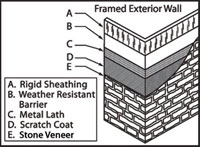
Framed Exterior Wall
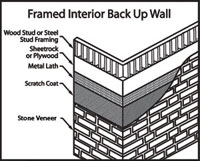
Framed Interior Wall
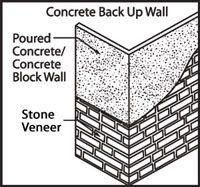
Concrete Interior or Exterior Wall
A scratch coat will be needed when metal lath is used. This step is not necessary when applying stone veneer to a cleaned concrete, masonry, or stucco surface.
1 part Type S Masonry Cement to 2.5 parts sand. Dry mix the sand and cement together and avoid creating clumps in the mixture. Add water slowly to the mixture a little at a time, continually mixing until you have achieved the consistency of a paste or whipped potatoes. Mix a minimum of 5 minutes.
If a scratch coat is necessary, use a masonry trowel to apply a 1/2" to 3/4" layer of the scratch coat mix over your metal lath. Cover the entire area of the lath, working the cement into the holes and scraping off any excess. Use a notched trowel to lightly rake horizontal grooves in the scratch coat while the cement is still slightly wet and allow to dry for 24 hours.

Applying Scratch Coat to Metal Lathe
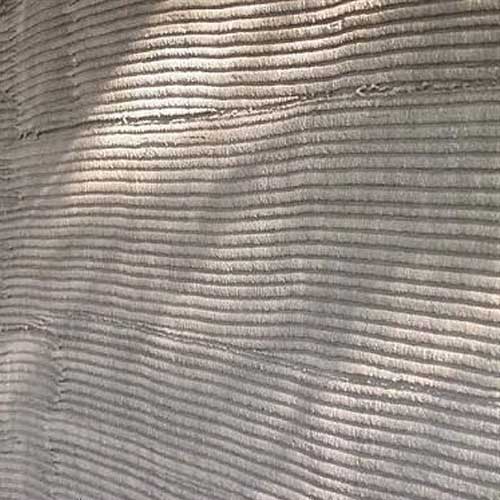
Grooves Will Help Mortar Bond
To achieve the best results, there are a few things you should take care of before starting your stone veneer installation.
Before applying the stone, it is a good idea to lay the stone out flat to determine the sizing and colors of each individual piece, how they will be laid out for your project, and if any trimming is necessary. Attempt to keep joints a consistent height and width. Normally vertical and horizontal joints should be staggered to prevent long, unbroken lines that may draw the eye to a particular area.
If cutting the stone is necessary, a Skill saw with either a dry or wet cut diamond or masonry blade will work. You may also want to use a masonry hammer to break the stone, giving it a more natural appearance. A nipper can also be used to trim small amounts off the stone.
Be certain that the surface of the stone is free of dust, dirt, or any loose particles. If necessary, wash the stone completely and allow to dry.
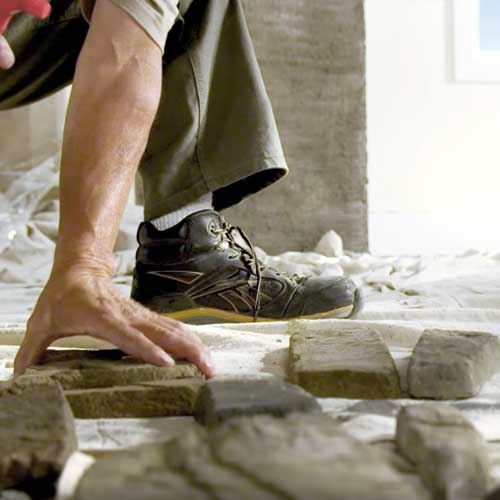
Plan Your Layout Before Installing
You will be affixing the stone veneer to the scratch coat using a stone veneer mortar. Below are the steps involved.
Use a pre-blended, polymer fortified Type S mortar and water known as SVM (Stone Veneer Mortar). Call an RCP Block & Brick near you for available products and tips. Mix according to manufacturer's directions.
It is recommended to install all corner pieces first before installing the field. It is also recommended to work your way from the bottom to top.
Use a masonry brush or sponge to dampen the back of the stone, but do not saturate it. This prevents the stone from pulling moisture away from the mortar allowing it to dry naturally and with a stronger bond.
To lay the stone, use a masonry trowel to butter the back of the stone with 1/2" to 1" layer of mortar. Using your trowel, create a ridge around the outside back of the stone. This will create suction when putting the stone in place, which will help to hold the stone until the mortar sets up. Lay the stone against the wall, pressing and rotating slightly, forcing some of the mortar to squeeze out freely.
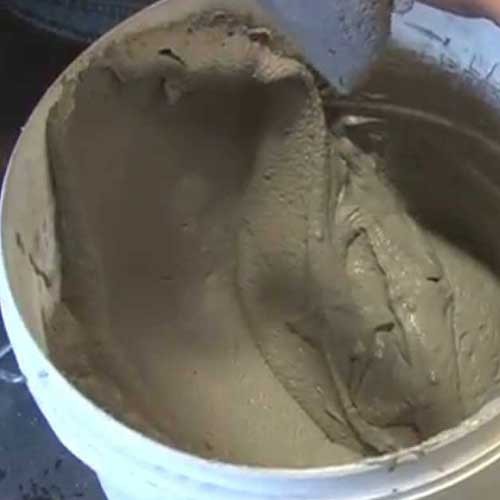
Mixing Stone Veneer Mortar (SVM)
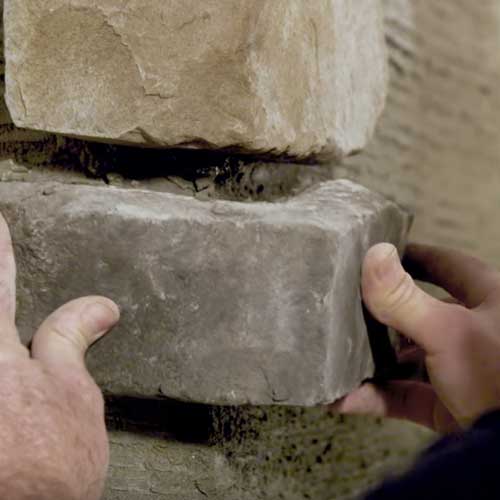
Installing the Stone Veneer
Once the stone has been affixed to the scratch coat using mortar, the joints, or gaps between the stone, will be filled with grout.
Use Pre-blended Type S mortar. Using a grout bag, cut a hole approximately 1/2" in the tip of the bag (if hole is not already provided). Fill your grout bag about half full with your grout mixture. Twist the top end of the bag and squirt a small amount into a bucket to prevent air pockets. Fill all the joints between the stones with about a 1/2" layer of mortar (more or less depending on the desired effect and joint size.)
As the grout stiffens, tool to the desired depth using a joint tool. Brush the joints with a whisk broom to smooth them out and clean away any loose mortar. Grout is ready for finishing when it crumbles away like sand when brushed. If the grout smears or falls away in large chunks, it is still too wet for brushing or striking. Finally use a soft bristled brush to sweep the dust off the stone.
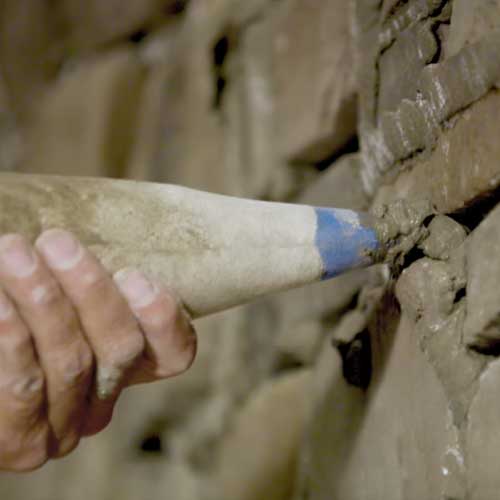
Grout Between Stone Pieces